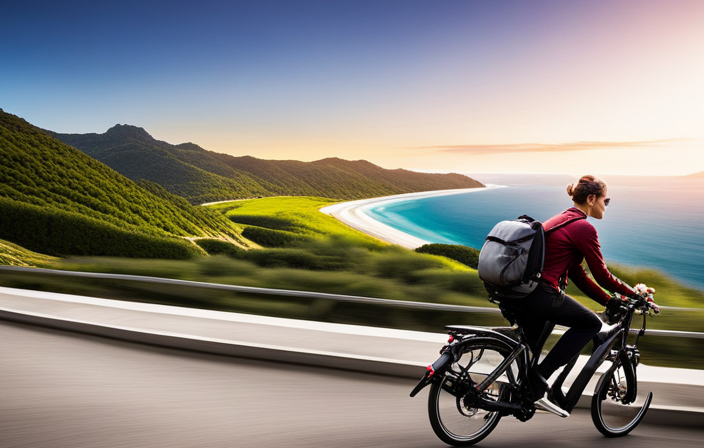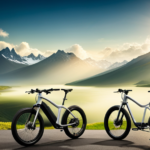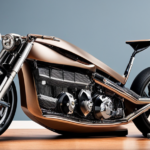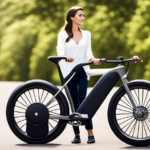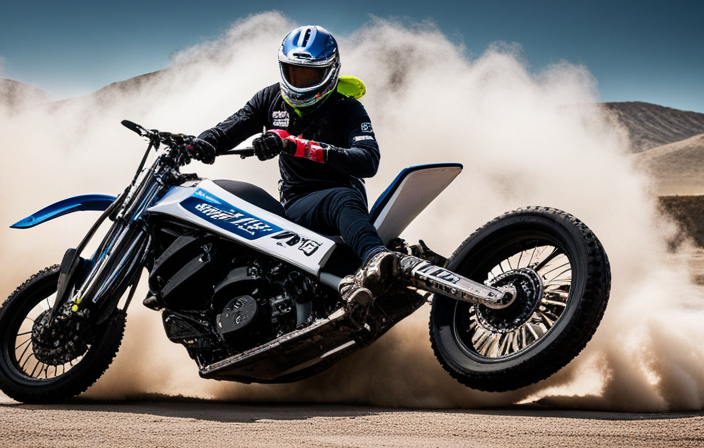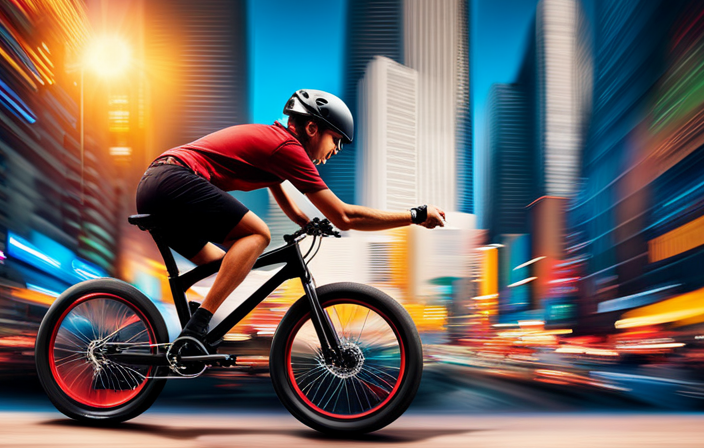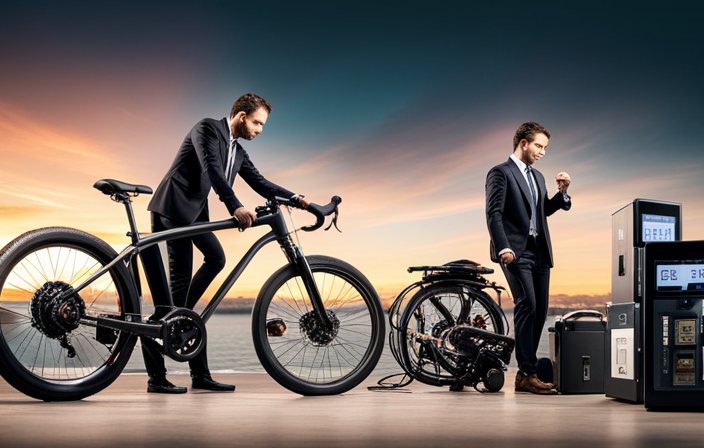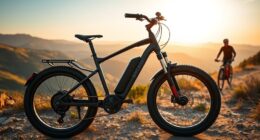Have you ever pondered how to extend the range of your electric bike and complete a remarkable 30-mile trip? Your search ends here, as I reveal the tips to achieving this goal.
By carefully selecting the appropriate battery, optimizing your riding style, and implementing various maintenance techniques, you can ensure that your electric bike performs at its peak efficiency.
Join me as I delve into the intricacies of achieving an extended range on your electric bike, providing you with the knowledge to embark on longer, more adventurous rides.
Key Takeaways
- Opt for lightweight materials like carbon fiber or aluminum for components.
- Choose a lightweight lithium-ion battery for ample power.
- Pack only essential items for your ride.
- By strategically planning your charging stops and understanding battery range estimation, you can confidently complete your 30-mile journey.
Choosing the Right Battery
When choosing the right battery, it’s important to consider its capacity and voltage. Battery capacity refers to the amount of energy it can store, and it plays a crucial role in determining how far an electric bike can run.
To ensure your bike can reach a distance of 30 miles, you’ll need a battery with a sufficient capacity. Look for a battery with a higher ampere-hour (Ah) rating, as this indicates a larger capacity and longer range.
Additionally, consider the charging time of the battery. Opt for a battery that can be fully charged within a reasonable time frame, such as 3-4 hours. This will allow you to quickly recharge your bike and get back on the road, without too much downtime.
Optimizing Your Riding Style
To maximize your riding efficiency, focus on fine-tuning your style. Proper body positioning is essential to optimize your electric bike’s performance. Maintain a balanced and upright posture, with your hands lightly gripping the handlebars and your feet securely on the pedals. This allows for better control and stability, reducing energy wastage during acceleration and deceleration.
Utilizing regenerative braking is another technique to extend your electric bike’s range. By applying gentle pressure to the brakes, energy is captured and stored back into the battery, increasing its overall efficiency. Anticipate the need to slow down or stop, and gradually apply the brakes rather than abruptly. This not only increases the lifespan of your brake pads but also harnesses the energy that would have been dissipated as heat.
By implementing these techniques, you can optimize your riding style and ensure your electric bike can comfortably run 30 miles on a single charge.
Managing Your Speed and Acceleration
Managing your speed and acceleration is crucial for maximizing the performance of your e-bike. To effectively manage your speed, it is important to be aware of how it affects your battery life. Maintaining a consistent speed rather than rapidly accelerating and decelerating can help conserve battery power, allowing you to travel longer distances. Additionally, adjusting your seat position can also impact your speed and acceleration. Finding the right seat position can improve your pedaling efficiency, enabling you to generate more power and achieve higher speeds. To assist you in managing your speed and acceleration, here is a table outlining the recommended speed ranges and seat positions for optimal performance:
| Speed Range (mph) | Seat Position |
|---|---|
| 0-10 | Lowered |
| 10-20 | Neutral |
| 20-30 | Raised |
By following these guidelines, you can effectively manage your e-bike’s speed and acceleration, while also maximizing battery life and overall performance.
Utilizing Pedal Assist
Using pedal assist on your e-bike can greatly enhance your riding experience and make it easier to reach higher speeds. Pedal assist is a feature that allows the motor to provide additional power to your pedaling, giving you a boost when you need it. Here are some benefits of utilizing pedal assist:
- Increased speed: Pedal assist allows you to maintain higher speeds with less effort, making your ride faster and more efficient.
- Extended range: By utilizing pedal assist, you can conserve battery power and extend the distance you can travel on a single charge.
- Uphill assistance: Pedal assist is especially helpful when climbing steep hills, as it provides extra power to help you conquer challenging terrain.
- Reduced fatigue: With pedal assist, you can pedal for longer periods without getting tired, allowing you to enjoy longer rides without feeling exhausted.
However, it’s important to be aware of the limitations of pedal assist:
- Limited control: Pedal assist can make it difficult to control your speed, especially when going downhill. It’s important to use caution and have good braking skills.
- Battery dependence: Utilizing pedal assist uses more battery power, so you may need to recharge your e-bike more frequently.
- Higher cost: E-bikes with pedal assist tend to be more expensive due to the additional technology and components required.
Overall, pedal assist is a valuable feature that can greatly enhance your e-bike riding experience, providing benefits such as increased speed and extended range. However, it’s important to understand its limitations and ride responsibly to ensure a safe and enjoyable experience.
Monitoring Tire Pressure and Suspension
Monitoring tire pressure and suspension is crucial for maintaining optimal performance and comfort while riding an e-bike. To ensure that your electric bike runs 30 miles smoothly, it is important to regularly check the tire pressure.
Proper tire pressure ensures better traction, stability, and energy efficiency. Low tire pressure can lead to increased rolling resistance, making it harder for the bike to reach the desired distance.
Similarly, keeping an eye on suspension settings is essential. Adjusting the suspension to match your weight and riding style improves overall comfort and control. It also helps in absorbing shocks and vibrations, reducing fatigue during longer rides.
Additionally, monitoring battery life is vital to ensure your e-bike does not run out of power before reaching the desired distance. Regularly checking the battery level and recharging as needed will help you maintain a consistent 30-mile range.
Minimizing Wind Resistance
To minimize wind resistance, make sure you position your body in a streamlined manner while riding your e-bike. This means reducing drag and adopting an aerodynamic positioning. To achieve this, keep your upper body low and your elbows tucked in. This helps to reduce the frontal area exposed to the wind. Additionally, try to maintain a consistent pedaling cadence to avoid sudden bursts of speed, which can create more drag. It is also important to wear fitted clothing that does not flap in the wind. Utilizing a fairing or windshield on your e-bike can further reduce wind resistance. By implementing these strategies, you can maximize efficiency and increase your e-bike’s range, allowing it to run for 30 miles or more on a single charge.
| Strategies to Minimize Wind Resistance | Benefits |
|---|---|
| Lowering your upper body and tucking in your elbows | Reduces frontal area exposed to wind |
| Maintaining a consistent pedaling cadence | Avoids sudden bursts of speed and increased drag |
| Wearing fitted clothing | Prevents flapping in the wind |
Efficient Gear Shifting
After discussing the importance of minimizing wind resistance, let’s now delve into the crucial aspect of efficient gear shifting.
When it comes to maximizing the range of your electric bike and achieving a 30-mile run, mastering proper technique and gear selection is paramount.
Proper technique involves smoothly shifting gears without applying excessive force or causing unnecessary strain on the drivetrain. This not only optimizes power transfer but also minimizes the risk of damaging your bike’s components.
Additionally, selecting the appropriate gear for the terrain and your desired speed helps maintain an efficient cadence, preventing you from overexerting yourself and draining the battery prematurely.
By understanding the nuances of gear shifting and employing the right technique, you can ensure a seamless and energy-efficient ride, ultimately reaching your desired 30-mile mark with ease.
Avoiding Excessive Weight
To ensure an efficient and effortless ride, you’ll want to avoid carrying excessive weight on your e-bike. Maximizing range and reducing weight are key factors in getting your electric bike to run 30 miles. Here are some crucial tips to help you achieve this:
-
Opt for lightweight materials: Choose components made from lightweight materials such as carbon fiber or aluminum to reduce overall weight.
-
Streamline accessories: Remove any unnecessary accessories or gear that add unnecessary weight, such as bulky racks or heavy lock systems.
-
Choose a lightweight battery: Look for lithium-ion batteries, as they are lighter than other options and still provide ample power.
-
Pack essentials only: Before your ride, carefully consider what you truly need to bring along and leave behind any non-essential items.
By following these guidelines, you can significantly reduce the weight of your electric bike, maximizing its range and ensuring you reach that desired 30-mile mark effortlessly.
Regular Maintenance and Care
Regular maintenance and care are essential in keeping your e-bike in optimal condition. By following a regular maintenance schedule, you can maximize the battery life of your electric bike and troubleshoot common issues before they become major problems. Here are some key maintenance tasks to consider:
| Task | Frequency | Description |
|---|---|---|
| Cleaning | Monthly | Use a gentle detergent and a soft cloth to clean the bike’s surfaces. |
| Tire Inspection | Weekly | Check for any signs of wear or punctures and inflate the tires as needed. |
| Chain Lubrication | Monthly | Apply a few drops of lubricant to the chain to ensure smooth operation. |
In addition to these tasks, it is important to regularly check the brakes, lights, and electrical connections. By taking the time to perform these maintenance tasks, you can ensure that your e-bike runs smoothly and efficiently, allowing you to enjoy those 30-mile rides without any issues.
Planning Your Route and Charging Stops
When planning your route, make sure to identify charging stops along the way for your e-bike. It is crucial to know the locations of charging stations to ensure that your electric bike can cover the full 30-mile distance.
To estimate the battery range, consider factors such as the bike’s battery capacity, the weight of the rider and any cargo, and the terrain of your planned route.
Researching and mapping out charging station locations in advance will help you determine where to stop and recharge. Look for charging stations that are conveniently situated along your route, allowing you to take breaks and replenish your battery as needed.
By strategically planning your charging stops, you can confidently embark on your 30-mile journey with peace of mind.
Frequently Asked Questions
Can I use a regular bike battery for an electric bike?
No, a regular bike battery cannot be used for an electric bike. Electric bike batteries have higher voltage and capacity requirements to power the motor and provide the necessary range.
How can I increase the range of my electric bike?
To increase the range of my electric bike, I can optimize power usage and increase battery life. This can be achieved by using energy-efficient components, maintaining proper tire pressure, and employing efficient riding techniques like pedaling in combination with electric power.
What are the safety precautions to take when riding an electric bike?
When riding an electric bike, it is crucial to prioritize safety. This includes wearing the proper gear such as a helmet, gloves, and reflective clothing. Regular bike maintenance is also important to ensure optimal performance and minimize accidents.
Can I ride my electric bike in the rain?
Yes, you can ride an electric bike in the rain. However, it is important to take precautions and perform regular maintenance to ensure the bike’s safety and performance in wet conditions.
What are the legal requirements for riding an electric bike on public roads?
To legally ride an electric bike on public roads, one must adhere to certain requirements. These include having a valid driver’s license, following traffic laws, using proper lighting and signaling devices, and ensuring the bike meets the specific regulations set by the local authorities.
Conclusion
In conclusion, achieving a 30-mile range on your electric bike requires careful consideration and implementation of various factors. By selecting the appropriate battery and adopting an optimized riding style, you can maximize your bike’s efficiency. Managing speed and acceleration, as well as utilizing pedal assist, are key aspects to consider. Additionally, monitoring tire pressure and suspension, ensuring efficient gear shifting, and avoiding excessive weight are important for maintaining optimal performance. Conducting regular maintenance and planning your route and charging stops strategically are also crucial for a successful journey. With all of these elements in place, your electric bike can offer a symphony of efficiency, freedom, and exhilaration.
